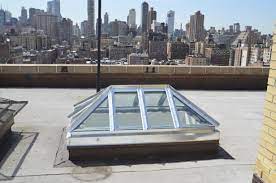
Skylights provide up to five times the natural light of normal windows while still being energy efficient. Existing skylights can be replaced with contemporary systems without increasing the aperture. The cost of installation is determined by whether the Skylight Installation Queens NY in the roofline or in a bespoke bulkhead.
Looking to spruce up your abode? Skylights bring in up to five times more natural light than ordinary vertical windows, and installing them is easier—and more historically appropriate—than you may imagine. Skylights were initially installed above stairwells in 19th-century townhouses to ventilate the building’s interiors prior to the invention of air conditioning.
Whether you design around what’s already there or start from fresh, the job can cost a little or a lot depending on the skylight itself and any structural constraints, such as walking on it.
However, the extra cost might be worthwhile: Skylights can save energy by capturing the warmth of the sun in the winter and allowing warm air (which rises) to escape in the summer. They can also allow access to the roof Sky247 without the need for an expensive bulkhead. Don’t forget the established health advantages of receiving your daily dose of sunshine.
Still, increased illumination is the primary reason to include skylights in your renovation plans—especially if you are working from home more frequently and miss those soaring office windows. Skylights have long been employed by David Sherman, principal of Abelow Sherman Architects, to provide more light into the middle of townhouses, which are generally long and narrow with windows on the front and rear.
Bespoke Architecture’s founding partner, Peter Holtzman, has also employed skylights in historic and Passive House buildings.
And, now that high-end new developments are installing skylights in their penthouses, the feature may become more of a wish-list item for potential buyers if you decide to sell. (Side note: Even high-end short-term apartments in this area have skylights. Welcome to New York City 2.0.) As a result, the resale value is in your advantage.
Consider the following projects when determining whether or not to use skylights in your makeover. Existing skylights should be updated.
If you currently have skylights, you may wish to upgrade to more contemporary systems that are airtight and waterproof and come in a variety of sizes, shapes, and architectural styles. Instead of a manual crank, you may manage ventilating and operating models using your smartphone.
As long as you keep the same aperture, the cost of the skylight plus installation is all that matters. (A cost breakdown is shown below.)
Sherman replaced an existing stair skylight in a Park Slope brownstone with an acid-etched laylight a few feet underneath it “to help avoid that dramatic darkening when a cloud covers the sun.” (This is standard procedure in the majority of his initiatives.) He also designed a facet with sloping walls going up to it to diffuse light down the steps.
Installing skylights in the roofline rather than on a sloping surface
Installing skylights in the roofline is the most cost-effective option since it eliminates the need for all of the extra work, materials, and permits required to build a bulkhead or other elevated structure. After the hole is cut, the skylight is installed inside, either level with the roof or on a shallow base (as seen in Rove’s Astor Place penthouse duplex rental above). In any case, the light is placed with flashing around the frame to ensure water tightness.
One disadvantage of using a flat skylight in New York is that rainfall and snow can pool and freeze on the glass. However, this is easily solved by using a curbed installation, in which the border is angled to allow for runoff.
Another option is to go with softly curved or domed versions, or traditional (period-appropriate) pyramidal designs, as shown above in The Brooklyn Studio’s Italianate Cobble Hill townhouse refurbishment.
Building a slanted building on a level roof is a more costly option. Bespoke, for example, installed four smaller skylights (two of which are ventilated) in a bulkhead designed specifically for that purpose in a recent significant gut renovation (or more like a whole rehabilitation) of a historic Harlem brownstone.








